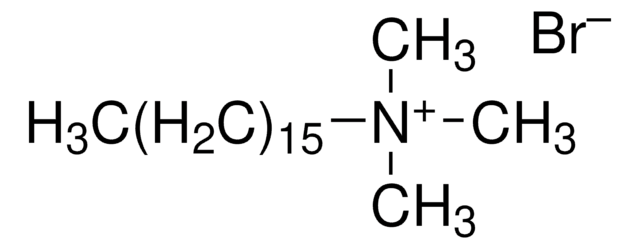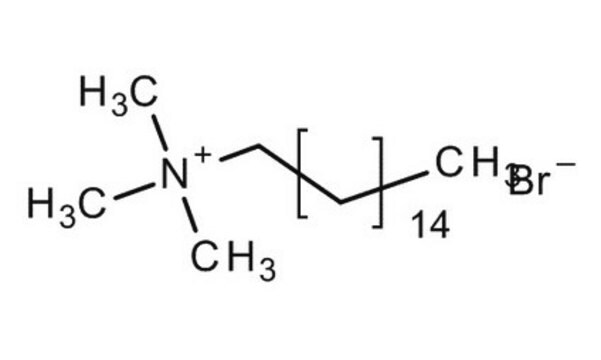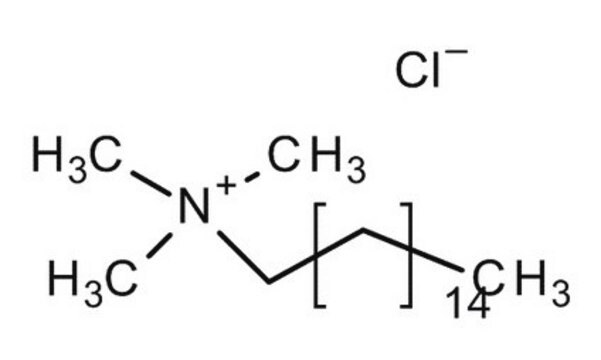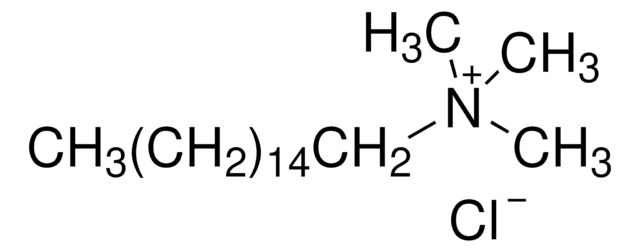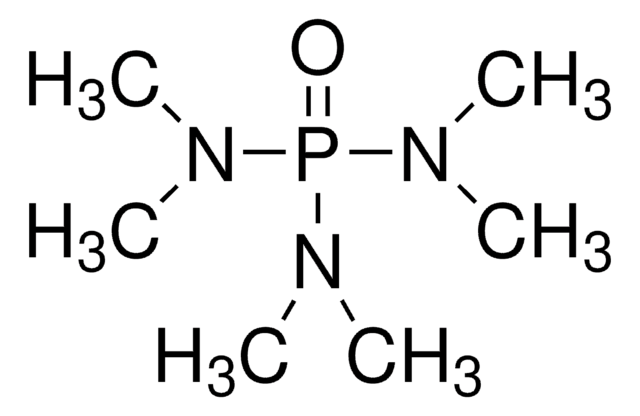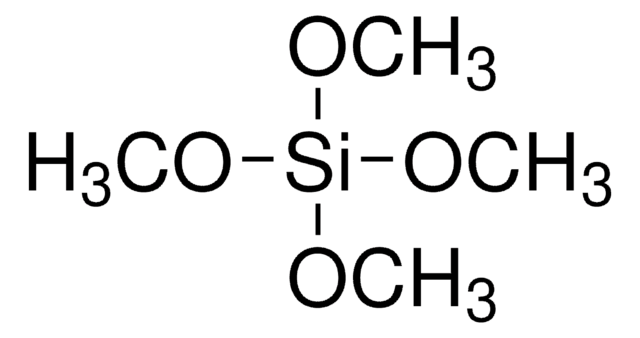52370
Hexadecyltrimethylammonium bromide
≥96.0% (AT)
Synonim(y):
CTAB, Cetrimonium bromide, Cetyltrimethylammonium bromide, Palmityltrimethylammonium bromide
About This Item
Polecane produkty
opis
cationic
Poziom jakości
Próba
≥96.0% (AT)
Postać
powder or chunks
masa cząsteczkowa
364.45 g/mol
metody
UV/Vis spectroscopy: suitable
electrophoresis: suitable
mp
248-251 °C (lit.)
rozpuszczalność
H2O: 1 g/10 mL (warm)
Zastosowanie
detection
ciąg SMILES
[Br-].CCCCCCCCCCCCCCCC[N+](C)(C)C
InChI
1S/C19H42N.BrH/c1-5-6-7-8-9-10-11-12-13-14-15-16-17-18-19-20(2,3)4;/h5-19H2,1-4H3;1H/q+1;/p-1
Klucz InChI
LZZYPRNAOMGNLH-UHFFFAOYSA-M
Szukasz podobnych produktów? Odwiedź Przewodnik dotyczący porównywania produktów
Powiązane kategorie
Opis ogólny
Zastosowanie
<li><strong>Sensitive detection in spectroscopy:</strong> The surface-active properties of Hexadecyltrimethylammonium bromide enhance the FRET effect in Cu-doped NH2-MIL-88(Fe), used for the highly sensitive detection of 3-nitro-L-tyrosine in biomolecular spectroscopy, contributing to advancements in diagnostic techniques and chemical analysis (Xu et al., 2024).</li>
<li><strong>Stabilization of heavy metals:</strong> Utilized in the intercalation-exfoliation modification of vermiculite for the stabilization of heavy metals during the pyrolysis of solid waste and sludge, Hexadecyltrimethylammonium bromide shows potential in waste management and pollution control, contributing to safer environmental practices (Yang et al., 2024).</li>
</ul>
Hasło ostrzegawcze
Danger
Zwroty wskazujące rodzaj zagrożenia
Zwroty wskazujące środki ostrożności
Klasyfikacja zagrożeń
Acute Tox. 4 Oral - Aquatic Acute 1 - Aquatic Chronic 1 - Eye Dam. 1 - Skin Irrit. 2 - STOT RE 2 Oral - STOT SE 3
Organy docelowe
Gastrointestinal tract, Respiratory system
Kod klasy składowania
11 - Combustible Solids
Klasa zagrożenia wodnego (WGK)
WGK 3
Temperatura zapłonu (°F)
471.2 °F - closed cup
Temperatura zapłonu (°C)
244 °C - closed cup
Środki ochrony indywidualnej
dust mask type N95 (US), Eyeshields, Faceshields, Gloves
Choose from one of the most recent versions:
Masz już ten produkt?
Dokumenty związane z niedawno zakupionymi produktami zostały zamieszczone w Bibliotece dokumentów.
Klienci oglądali również te produkty
Nasz zespół naukowców ma doświadczenie we wszystkich obszarach badań, w tym w naukach przyrodniczych, materiałoznawstwie, syntezie chemicznej, chromatografii, analityce i wielu innych dziedzinach.
Skontaktuj się z zespołem ds. pomocy technicznej